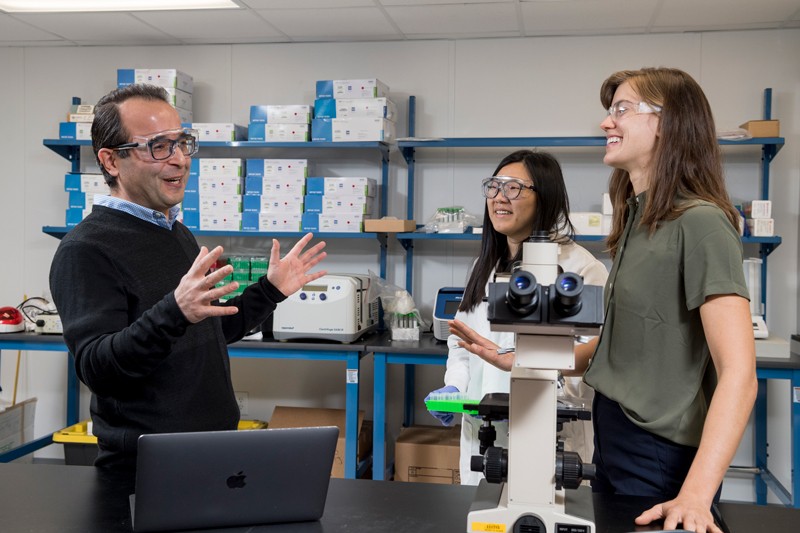Study suggests lipoprotein lipase enzyme as root cause of wooden breast syndrome in broiler chickens.
November 21, 2019

University of Delaware researchers have discovered that lipoprotein lipase — an enzyme crucial for fat metabolism — may be contributing to wooden breast syndrome in broiler chickens.
Wooden breast syndrome can affect broiler chickens, making the meat hard and chewy, the university explained in an announcement. It is a costly problem that can render the birds unmarketable, causing significant economic losses for growers, who sometimes see the disease in up to half of their flocks.
The University of Delaware research team, led by associate professor of animal and food sciences Behnam Abasht in the university's College of Agriculture & Natural Resources, have identified gene expression irregularities at the onset of wooden breast syndrome that suggest that the disease is a metabolic disorder characterized by abnormal fat accumulation in the breast muscle tissue.
The research team reported their results Nov. 20 in the journal Scientific Reports.
The findings could help drive short-term solutions to help growers manage the condition in chickens at the production level through feed additives or supplements or to reduce the number of birds that develop the condition, Abasht said.
"The industry desperately needs a solution right now. Conservative estimates project that wooden breast syndrome is costing the U.S. agricultural community $200 million per year, but this number may be much higher," Abasht said.
The U.S. is a leader in broiler chicken production worldwide. Delaware has more than 700 producers who raise commercial broiler chickens and more than 1,000 small backyard poultry owners. Wooden breast syndrome is a concern around the world, too, as global consumption of chicken has risen in recent years as a leading source of dietary protein.
The research also could inform human health research related to metabolic syndromes such as diabetes and atherosclerosis, which is associated with fatty deposits in the arteries, the university said.

Source of the problem
Abasht has been studying wooden breast syndrome in broiler chickens for nearly a decade. In previous work, his research team analyzed the genes involved in the disease and identified biomarkers for the disorder. They also characterized the unique biochemistry of the hardened breast tissue in chickens with the disease.
In their current work, the University of Delaware research team noticed that the expression of lipoprotein lipase was higher in chickens affected with wooden breast syndrome, leading more fat to accumulate in the chicken's pectoral (or breast) muscles. Lipoprotein lipase serves as a "metabolic gatekeeper" that determines how much fat is allowed inside a given tissue.
This was curious, because breast muscle fibers in chicken typically rely on sugar (glucose) molecules for fuel, not fat molecules, the researchers said.
The research team used RNA sequencing to determine which genes were being expressed in modern fast-growing broiler chickens and slower-growing legacy chickens. They then employed a new technology, called RNA in situ hybridization, to pinpoint exactly where this gene expression occurred inside the muscle.
The researchers found genetic evidence of lipoprotein lipase being expressed in endothelial cells in chickens, which was previously unknown. Endothelial cells are present in all blood vessels and serve as a barrier between the blood and the surrounding tissue.
Abasht hypothesized that when more fat is oxidized for energy in the breast tissue of chickens, it may cause the excessive release of free-radical molecules that would modify (damage) fats and proteins in the muscle, prompting the chicken's immune system to kick in to clear up the problem.
"We observed that, if a particular vein was attacked by immune cells, the same vein typically also expressed higher levels of lipoprotein lipase," Abasht said.
The researchers went a step further and compared the data with the gene expression signals found in two commercial broiler chicken lines at three weeks of age and again at market age. In their analysis, the researchers found signals consistent with the fact that young chickens may be showing the same changes associated with wooden breast syndrome as market-age broiler chickens, even before the disease shows up.
The findings could provide potential markers to identify chickens that will develop the disease.
In recently published research in Genes, the researchers also reported finding common features between wooden breast syndrome in chickens and diabetes complications in humans, specifically diabetic cardiomyopathy, a chronic disease characterized by molecular and structural changes in the heart muscle, the University of Delaware said.
Abasht's research team is currently reviewing available literature for treating diabetes to see if there are ways to apply similar approaches to help broiler chickens avoid — or cope — with wooden breast syndrome through diet, supplements or medication. If they can find common solutions, Abasht said, a far-reaching goal of the work might be to use chickens as a model to study possible treatments for diabetes in people.
"Our main focus was to address this problem from an agricultural perspective, but our findings open new horizons for future research that could benefit both agriculture and human health. This is a very interesting prospect for us," Abasht said.
Longer term, Juniper Lake, a doctoral student in Abasht's lab, said having a deeper understanding of the genetic causes behind the disease could lead to solutions for agricultural producers to selectively breed out the traits that cause wooden breast disease, which has a relatively high heritability.
"There's a lot to be gained from basic research of wooden breast, even if the main goal is to mitigate economic losses in the poultry industry," Lake said.
The University of Delaware research team's work to characterize the genetic basis of wooden breast syndrome is part of an ongoing collaborative study among the University of Delaware, Iowa State University and The Ohio State University that is funded by the U.S. Department of Agriculture.
You May Also Like

.png?width=300&auto=webp&quality=80&disable=upscale)

